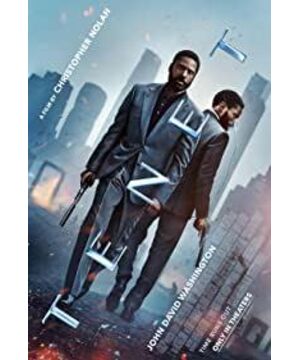Preface
Today's article is more complicated.
First of all, I need to do some analysis (this seems to have become a standard feature of Nolan's movies), but since there are already many frame-by-frame interpretations on the Internet, I don't need to do repetitive work. I want to change the angle and start with the most basic sci-fi setting of this movie to ensure that audiences who are not familiar with sci-fi can get started and understand the movie's generality.
Secondly, I will make a film review, but in fact, the film itself doesn't have much to say. It amplifies Nolan's advantages and disadvantages.
Finally, starting from this movie, I also intend to objectively evaluate Nolan, especially his contributions to science fiction and film.
The next three parts are the expansion of these three topics.
1. Looking at the "Creed" from the perspective of economic models
As a science fiction fan with a background in economics, I had a very strong feeling when I watched "Creed": Nolan is simply doing science fiction with the mentality of being an economic model.
How to make an economic model? First make premises and assumptions, then reason and draw conclusions. For example, suppose there are two manufacturers in a market, making output decisions at the same time, and finally finding their respective output-this is a "Cournot model".
This model is very fun, because it can make various variants, which is mainly achieved by changing the premises. Should I let them make price decisions at the same time? Do I let them make decisions at the same time? I changed the two manufacturers to three or four or five?
It is generally believed that the more complex an economic model is, the closer it is to reality, and the more it can explain reality; of course, a bunch of paper will come out.
Science fiction and economics have similarities in this sense. Economics depends on economic settings, and science fiction also depends on sci-fi settings.
The masters who are good at playing with economic settings have published top publications; Nolan, the master who is good at playing with sci-fi settings, won the title of "brain-burning".
Just as undergraduates can't look at too complicated economic models, audiences who don't understand science fiction will be confused at first glance (or even analysis) of Nolan movies. In fact, just as the economic model changes from simple to complex; "Creed" evolved from some relatively simple sci-fi settings.
One of the most basic sci-fi settings it uses is: time meets, that is, two people walk towards each other in the timeline. This is a bit like the space encounters learned in elementary school mathematics.
The simplest case of time encounter is discrete time encounter: A continuously goes from the past to the future (blue arrow); B jumps from the future to the past, usually through the time machine (red arrow); they may meet three times on the way, each time they say A few words (white arrow), and then B jumps forward. But pay attention: the first time A saw B, it was the third time B saw A, and vice versa.
Works with this setting include: Belgian science fiction writer Frank Roger's short story "Incurable" (published in "Science Fiction World" 2008 Issue 6), the 2019 Netflix movie "Moonshadow Killing" and so on.
A more complicated situation is the continuous time encounter: A continues from the past to the future (blue arrow), and B continues from the future to the past (red arrow); they may also meet three times on the way and say a few words (black dotted box) ). Of course, the problem can be seen here: then A may not understand B at all! Because from A's point of view, B said it backwards.
At this time, it’s time to patch the settings. For example, Japanese science fiction writer Shinji Kajio’s short story "Portrait of Toki" (Journal of Science Fiction World, Issue 5, 2007) supplemented this way: "They used twenty-four hours They will go back one day in the past. Therefore, they are not even the way of walking and talking as I imagined before. They are rebellious." In this way, when A and B meet, the time direction is still the same (white arrow).
Can you still play like this? Science fiction writers are as crazy as economists in playing with settings.
Nolan chose model 2 as the basic model here, but made extremely complex deformations, mainly due to two points:
First, everyone's time direction can be changed, both direct and retrograde.
In fact, this transformation was not the first creation of Nolan. This is how the American science fiction writer Frederick Brown's 1961 mini-fiction "The Doomsday" (the 23rd issue of the "Reader") did it:
end
(United States) Frederick Brown
Professor Jones has been studying time for many years.
"I finally invented a machine," he said to his daughter, "it can take us back in time."
He pressed the button on the machine and said:
"The machine can make time go back."
". When walking back to the room, let the energy machine"
: Say yes, the upper device of the button button presses him next
"I have been to the back and I will take it", say the children to him", the machine will be sent to me as soon as the machine is clear."
. In Zhiyi, he has taught Sjoan for more than the next year.
Rambe Criedley (United States)
End of day
But Nolan let the character jump repeatedly between forward and backward, forward and backward, and backward and forward, so that a person can play for himself.
Just like the revolving door in Oslo, Norway, there are three protagonists (black dashed frame) at the same time, and oneself and oneself exist in the same direction and facing each other at the same time.
Another example is Neal's continuous reverse-forward-reverse trajectory in Russia's Stark City 12 in a short period of time.
Second, there are more than two people in the model, but four people: the protagonist (The Protagonist), Neil (Neil), Kate (Kat), Andrei Sator (Andrei Sator).
It has to be said that Nolan’s innovations in this traditional science fiction model are extremely limited: he only increased the number of changes in the two time directions, only increased the number of people-in short, both are quantitative. , Not structural. But the entanglement of these variables can cause the complexity of the film's model to skyrocket exponentially. It's really messy, I don't want to draw it anymore. There are many pictures on the Internet, please borrow them here. See the watermark for the source.
At first glance, it is still very messy, but after the introduction of the previous basic model, viewers who are not familiar with science fiction and still confused by the analysis should be able to grasp the story as a whole. As for the details, you can go to the second brush or leave it alone. Anyway, when I read papers, I often only read abstracts and add conclusions.
So when I watched the movie, I admired Nolan very much. He could combine the simple basic models of his predecessors and play so many tricks. If he became an economist, he would be able to publish a bunch of papers.
2. "Modelized" movies
There are roughly two reasons for Nolan’s film "brain burn": one is caused by non-linear narratives, such as "Shards of Memory" and "Fatal Magic"; the other is the introduction of complex models, such as "Inception" and "Interstellar" . This "creed" also belongs to the latter.
What else is there to say about a "modeled" movie? After all, the meaning of its existence is to show the audience a good model (alas, I have to complain again, and the meaning of many economic models is also the same).
From the perspective of "showing a good model", "Creed" is still very successful. Its model is more complex than "Inception" and "Interstellar"; and after making such complex changes to the model, it has achieved "three basics": it basically explains the settings and basically maintains it. The logic is self-consistent, and the ending is basically surprising. This is also Nolan's consistent advantage.
The disadvantage is also obvious, that is, in addition to other aspects of the model:
First, the action drama is perfunctory, this is Nolan's old problem. In fact, the protagonist’s kitchen fight has made considerable progress compared to the "Batman" trilogy; the climax of the Russian gunfight is another random shooting-the "chaos" here has nothing to do with time disorder, it is simple The individual skills are not enough.
Second, the lack of rhythm in editing and shots is also Nolan's old fault. For example, the frequent black screen transitions in the movie make the movie show a clear sense of fragmentation; the gun battle at the climax in Russia is also chaotic. The camera is a little far away and it is impossible to identify the masked character, and armbands are not acceptable.
Third, the emotion is weakened, which is quite unexpected. Nolan's films, whether they burn their brains or not, the themes are usually emotions. As he said: "My opinion does not represent anyone's opinion, but I believe that all movies are evolved from the idea of love." Some people may criticize his works for superficial emotional themes (nothing more than " Love”), but no one would say that his works lack emotion. In "Inception" and "Interstellar", Nolan gave the protagonist a very strong emotional motivation, and the whole movie is also very emotional. But in the "Creed", perhaps it is because the elaboration of the model takes up too much time, Nolan has almost no time to express his emotions. This time the protagonist is almost completely reduced to a tool person to show the charm of the model.
Because Nolan’s movies have these advantages and disadvantages, watching his movies is like watching magic-this is actually Nolan expressed very clearly in "Fatal Magic"-when you can't see through the magic, you I think there is such a miraculous thing in the world; but when you know the principle of magic, you immediately dismissed it again.
Probably this is why, people who like Nolan like it so much, people who don't like Nolan sneer.
3. Is Nolan a great god?
Then we are talking about Nolan himself. How do you evaluate him as a filmmaker? Is he a "great god"?
Let me talk about my conclusion first: he is a great god of both commercial films and science fiction.
Nolan’s filmmaking of course borrowed many art films from the filming methods, such as ambiguity, but in essence he made commercial films. Coupled with the various problems mentioned above, he is indeed hard to call a "great god" in terms of artistic attainments.
But throughout the history of Hollywood, few people can make the narrative or model itself into a dazzling spectacle like Nolan. Of course, some people might say that this can only show that Nolan is just a mechanic, not an art creator. I think it depends on how we define "art". Maybe Nolan’s magic has become rougher and not artistic enough, but it is still an amazing magic.
Nolan's contribution to science fiction should be more acceptable.
But he didn't make much contribution to the development of science fiction itself. As mentioned earlier, his innovations in traditional science fiction models are extremely limited. He is not like the "Big Three", Ridley Scott, or even Liu Cixin did something brand new. Because of this, senior science fiction fans are more or less dismissive of him, always feeling that his new bottle of old wine can only fool the layman (interestingly, some economists wrote books are also spit out in this way).
But Nolan's contribution to science fiction is also here: his "old wine in a new bottle" popularized abstract science fiction. For example, before him, there seems to be no film and television work that can visualize continuous time encounters, because this is too abstract. How do two people who are in opposite directions fight each other? Nolan photographed it for you! It can be found that most of the time these two guys are pushing together as if they are pushing Tai Chi, just as cause and effect here are like yin and yang.
Visualization is the best popularization method. Through visualization, more people appreciate the charm of abstract science fiction.
And Nolan also likes to use real shots, which makes such science fiction things look so real. In terms of visualizing the wonders of science fiction, probably no one can match Nolan's right.
Summarize
All of the above have resulted in "Creed" becoming Nolan's most polarized work.
On the one hand, it is obviously a little crazy in terms of "models", and the entertainment is too bad. The best balance between the two is "Inception", and "Interstellar" is already a little unbalanced, and in the end the imbalance of "Creed" has reached its extreme.
On the other hand, it persistently visualizes some abstract sci-fi concepts—dreams, black holes, and time—which is always surprising.
Nolan is a lame artist. This sentence is not a criticism, nor is it praise-or it is both.
Easter eggs
First of all, a friendly reminder, this is a flavorful egg.
The reason stems from a tasteful brain hole opened by a classmate based on the setting of this film...
It seems that this film still has a lot to be discovered!
View more about Tenet reviews











